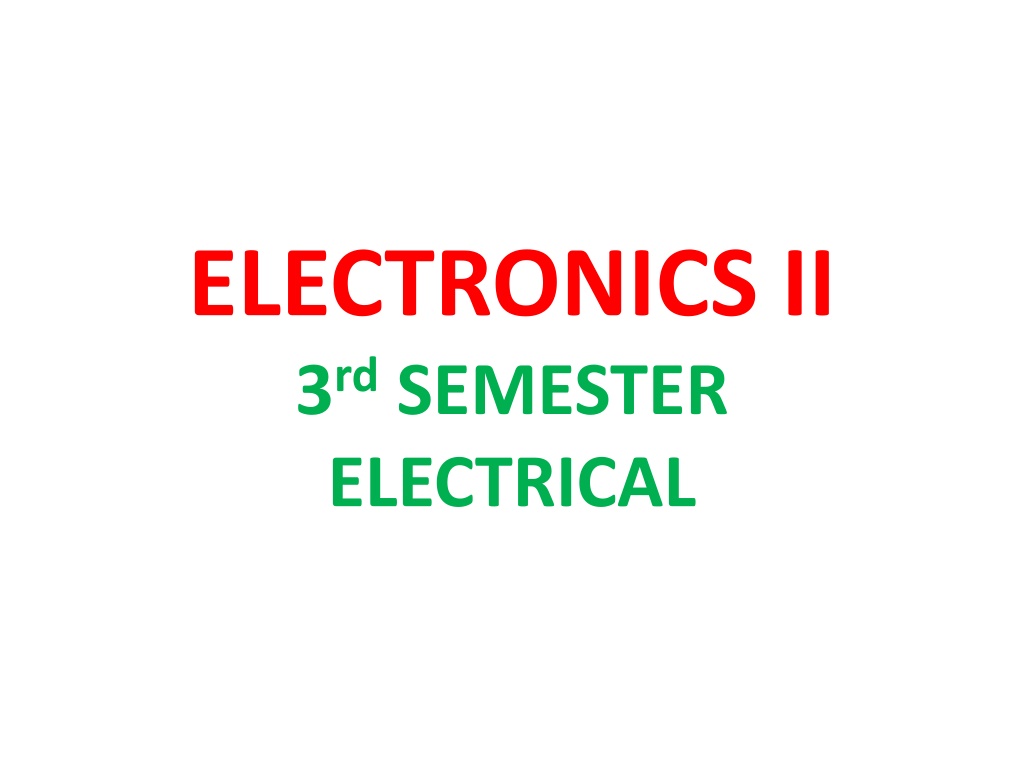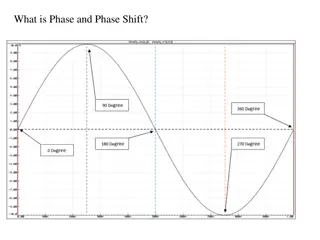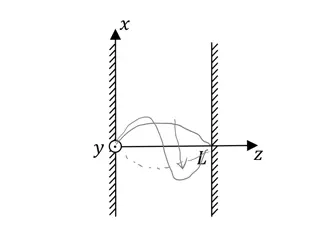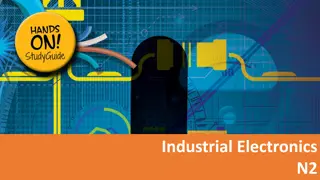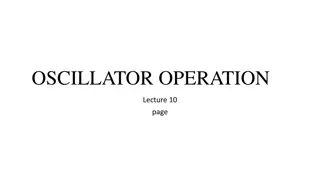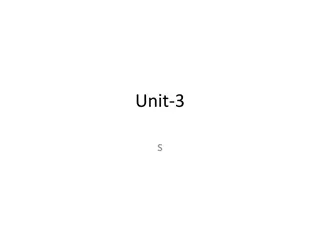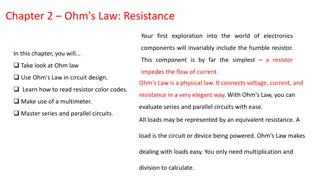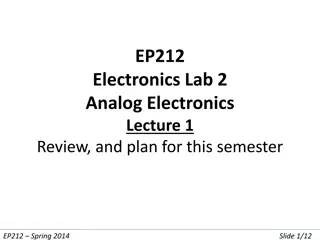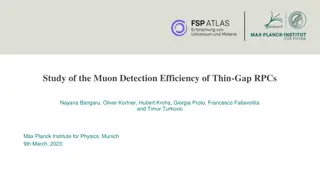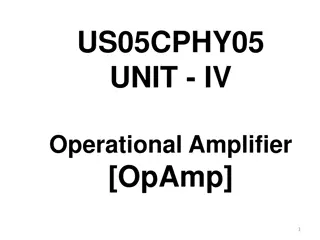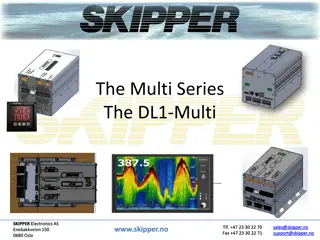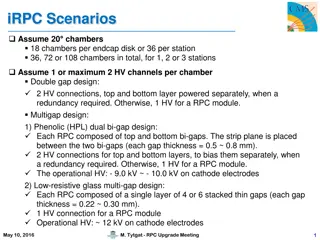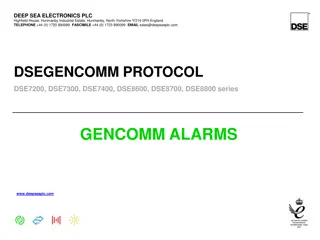Understanding Oscillators in Electronics
Explore the world of oscillators in electronics, including the operation of transistors in class-B and class-C amplifiers, the significance of achieving maximum swing, the theoretical efficiency of different amplifier classes, and the role of oscillators as signal generators in electronic circuits. Learn about various types of oscillators like RC, LC, crystal, and relaxation oscillators, along with specific examples such as the Wien-Bridge Oscillator and Phase-Shift Oscillator. Discover the applications of oscillators in generating periodic waveforms, converting DC to AC, and serving communication, digital, and test systems.
Download Presentation

Please find below an Image/Link to download the presentation.
The content on the website is provided AS IS for your information and personal use only. It may not be sold, licensed, or shared on other websites without obtaining consent from the author. Download presentation by click this link. If you encounter any issues during the download, it is possible that the publisher has removed the file from their server.
E N D
Presentation Transcript
ELECTRONICS II 3rdSEMESTER ELECTRICAL
CassA operation For maximum swing ( +ve and ve), transistor is biased such that the Q point is at centre of the load line. The transistor conducts for a full cycle of the input signal
Theoretical maximum efficiency of class-B amplifiers = sin v V V t CEn CC p = sin v V t O p 4
CassC operation Transistor conducts for less than half a cycle of input signal Tuned circuit is required. Used for RF amplifier. Efficiency > 78.5% B E junction is reverse-biased to obtain Q-point beyond cut-off.
Oscillator Oscillator is an electronic circuit that generates a periodic waveform on its output without an external signal source. It is used to convert dc to ac. Oscillators are circuits that produce a continuous signal of some type without the need of an input. These signals serve a variety of purposes. Communications systems, digital systems (including computers), and test equipment make use of oscillators
Need of an Oscillator An oscillator circuit is capable of producing ac voltage of desired frequency and waveshape. To test performance of electronic circuits, it is called signal generator. It can produce square, pulse, triangular, or sawtooth wave shape. High frequency oscillator are used in broadcasting. Microwave oven uses an oscillator. Used for induction heating and dielectric heating.
Types of Oscillator 1. RC Oscillator - Wien Bridge Oscillator - Phase-Shift Oscillator 2. LC Oscillator - Crystal Oscillator 3. Relaxation Oscillator
Wien-Bridge Oscillator It is a low frequency oscillator which ranges from a few kHz to 1 MHz. Structure of this oscillator is
Phase-Shift Oscillator Rf C C C Vo 0 V . R + R R Phase-shift oscillator The phase shift oscillator utilizes three RC circuits to provide 180 phase shift that when coupled with the 180 of the op-amp itself provides the necessary feedback to sustain oscillations.
Crystal Oscillator The crystal appears as a resonant circuit (tuned circuit oscillator). The crystal has two resonant frequencies: Series resonant condition RLC determine the resonant frequency The crystal has a low impedance Parallel resonant condition RLC and CM determine the resonant frequency The crystal has a high impedance The series and parallel resonant frequencies are very close, within 1% of each other.
What is the IC 555? The IC 555 is an 8-pin Integrated Circuit (IC) that is capable of producing accurate time delays and/or oscillations. DIP chip (Dual-Inline package)
What is an Op-Amp? An Operational Amplifier (known as an Op- Amp ) is a device that is used to amplify a signal using an external power source Op-Amps are generally composed of: Transistors, Resistors, Capacitors = + +
Terminals on an Op Amp Positive power supply (Positive rail) Non-inverting Input terminal Output terminal Inverting input terminal Negative power supply (Negative rail)
Typical Op Amp Parameters Parameter Variable Typical Ranges 105 to 108 Ideal Values Open-Loop Voltage Gain A 105 to 1013 Input Resistance Ri 10 to 100 0 Output Resistance Ro Vcc/V+ -Vcc/V- Supply Voltage 5 to 30 V -30V to 0V N/A N/A
Non-Inverting Op-Amp Amplifies the input voltage by a constant Closed loop op-amp Voltage input connected to non- inverting input Voltage output connected to inverting input through a feedback resistor Inverting input is also connected to ground Non-inverting input is only determined by voltage output
Inverting Op-Amp Vout=K(V+-V-) V-=Vout(Rin/(Rin+Rf))+Vin(Rf/(Rin+Rf)) V-=(VoutRin+VinRf)/(Rin+Rf) Vout=K(0-V-) Vout=-VinRf/[(Rin+Rf)/K+(Rin)] Vout=-VinRf/Rin
Integrating Op-Amp Integrates the inverted input signal over time Closed loop op-amp Voltage output is connected to inverting input through a capacitor The resistor and capacitor form an RC circuit Magnitude of the output is determined by length of time voltage is present at input The longer the input voltage is present, the greater the output
Op Amps Applications Audio amplifiers Speakers and microphone circuits in cell phones, computers, mpg players, boom boxes, etc. Instrumentation amplifiers Biomedical systems including heart monitors and oxygen sensors. Power amplifiers Analog computers Combination of integrators, differentiators, summing amplifiers, and multipliers
